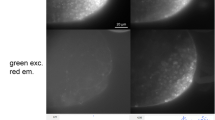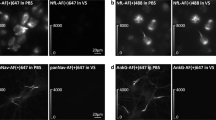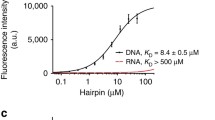Abstract
Immunocytochemistry is a powerful tool for detection and visualization of specific molecules in living or fixed cells, their localization and their relative abundance. One of the most commonly used fluorescent DNA dyes in immunocytochemistry applications is 4′,6-diamidino-2-phenylindole dihydrochloride, known as DAPI. DAPI binds strongly to DNA and is used extensively for visualizing cell nuclei. It is excited by UV light and emits characteristic blue fluorescence. Here, we report a phenomenon based on an apparent photoconversion of DAPI that results in detection of a DAPI signal using a standard filter set for detection of green emission due to blue excitation. When a sample stained with DAPI only was first imaged with the green filter set (FITC/GFP), only a weak cytoplasmic autofluorescence was observed. Next, we imaged the sample with a DAPI filter set, obtaining a strong nuclear DAPI signal as expected. Upon reimaging the same samples with a FITC/GFP filter set, robust nuclear fluorescence was observed. We conclude that excitation with UV results in a photoconversion of DAPI that leads to detection of DAPI due to excitation and emission in the FITC/GFP channel. This phenomenon can affect data interpretation and lead to false-positive results when used together with fluorochrome-labeled nuclear proteins detected with blue excitation and green emission. In order to avoid misinterpretations, extra precaution should be taken to prepare staining solutions with low DAPI concentration and DAPI (UV excitation) images should be acquired after all other higher wavelength images. Of various DNA dyes tested, Hoechst 33342 exhibited the lowest photoconversion while that for DAPI and Hoechst 33258 was much stronger. Different fixation methods did not substantially affect the strength of photoconversion. We also suggest avoiding the use of mounting medium with high glycerol concentrations since glycerol showed the strongest impact on photoconversion. This photoconversion effect cannot be avoided even when using narrow bandpass filter sets.






Similar content being viewed by others
References
Ando R, Mizuno H, Miyawaki A (2004) Regulated fast nucleocytoplasmic shuttling observed by reversible protein highlighting. Science 306(5700):1370–1373. doi:10.1126/science.1102506
Arndt-Jovin DJ, Jovin TM (1977) Analysis and sorting of living cells according to deoxyribonucleic acid content. J Histochem Cytochem 25(7):585–589. doi:10.1177/25.7.70450
Bacallao R, Sohrab S, Phillips C (2006) Handbook of biological confocal microscopy, 3rd edn. Springer, Berlin
Barcellona ML, Cardiel G, Gratton E (1990) Time-resolved fluorescence of DAPI in solution and bound to polydeoxynucleotides. Biochem Biophys Res Commun 170(1):270–280
Brunk CF, Jones KC, James TW (1979) Assay for nanogram quantities of DNA in cellular homogenates. Anal Biochem 92(2):497–500
Buel E, Schwartz M (1993) DAPI, a simple sensitive alternative to ethidium bromide staining of DNA in agarose gels. Appl Theor Electrophor 3(5):253–255
Crissman HA, Steinkamp JA (1982) Rapid, one step staining procedures for analysis of cellular DNA and protein by single and dual laser flow cytometry. Cytometry 3(2):84–90
Darzynkiewicz Z, Galkowski D, Zhao H (2008) Analysis of apoptosis by cytometry using TUNEL assay. Methods 44(3):250–254. doi:10.1016/j.ymeth.2007.11.008
Diaspro A, Federici F, Robello M (2002) Influence of refractive-index mismatch in high-resolution three-dimensional confocal microscopy. Appl Opt 41(4):685–690
Douglas RS, Pletcher CH Jr, Nowell PC, Moore JS (1998) Novel approach for simultaneous evaluation of cell phenotype, apoptosis, and cell cycle using multiparameter flow cytometry. Cytometry 32(1):57–65
Fritschy JM (2008) Is my antibody-staining specific? How to deal with pitfalls of immunohistochemistry. Eur J Neurosci 28(12):2365–2370. doi:10.1111/j.1460-9568.2008.06552.x
Grizzle WE (2009) Special symposium: fixation and tissue processing models. Biotech Histochem 84(5):185–193. doi:10.3109/10520290903039052
Kapuscinski J (1990) Interactions of nucleic acids with fluorescent dyes: spectral properties of condensed complexes. J Histochem Cytochem 38(9):1323–1329
Kapuscinski J (1995) DAPI: a DNA-specific fluorescent probe. Biotech Histochem 70(5):220–233
Kubista M, Akerman B, Norden B (1987) Characterization of interaction between DNA and 4′,6-diamidino-2-phenylindole by optical spectroscopy. Biochemistry 26(14):4545–4553
Latt SA, Stetten G (1976) Spectral studies on 33258 Hoechst and related bisbenzimidazole dyes useful for fluorescent detection of deoxyribonucleic acid synthesis. J Histochem Cytochem 24(1):24–33. doi:10.1177/24.1.943439
Latt SA, George YS, Gray JW (1977) Flow cytometric analysis of bromodeoxyuridine-substituted cells stained with 33258 Hoechst. J Histochem Cytochem 25(7):927–934
Life Technologies (2006) DAPI Counterstaining Protocols. http://www.invitrogen.com/site/us/en/home/References/protocols/cell-and-tissue-analysis/dapi-protocol/Basic-DAPI-Counterstaining-Protocols.html
Longin A, Souchier C, Ffrench M, Bryon PA (1993) Comparison of anti-fading agents used in fluorescence microscopy: image analysis and laser confocal microscopy study. J Histochem Cytochem 41(12):1833–1840
Lukyanov KA, Chudakov DM, Lukyanov S, Verkhusha VV (2005) Innovation: photoactivatable fluorescent proteins. Nat Rev Mol Cell Biol 6(11):885–891. doi:10.1038/nrm1741
Maciorowski Z, Veilleux C, Gibaud A, Bourgeois CA, Klijanienko J, Boenders J, Vielh P (1997) Comparison of fixation procedures for fluorescent quantitation of DNA content using image cytometry. Cytometry 28(2):123–129
Manzini G, Barcellona ML, Avitabile M, Quadrifoglio F (1983) Interaction of diamidino-2-phenylindole (DAPI) with natural and synthetic nucleic acids. Nucleic Acids Res 11(24):8861–8876
Martin RM, Leonhardt H, Cardoso MC (2005) DNA labeling in living cells. Cytometry A 67(1):45–52. doi:10.1002/cyto.a.20172
Melan MA (1999) Overview of cell fixatives and cell membrane permeants. Methods Mol Biol 115:45–55
Mocharla R, Mocharla H (1987) A novel, sensitive fluorometric staining technique for the detection of DNA in RNA preparations. Nucleic Acids Res 15(24):46223
Nairn RS, Dodson ML, Humphrey RM (1982) Comparison of ethidium bromide and 4′,6-diamidino-2-phenylindole as quantitative fluorescent stains for DNA in agarose gels. J Biochem Biophys Methods 6(2):95–103
Ono M, Murakami T, Kudo A, Isshiki M, Sawada H, Segawa A (2001) Quantitative comparison of anti-fading mounting media for confocal laser scanning microscopy. J Histochem Cytochem 49(3):305–312
Otto F, Tsou KC (1985) A comparative study of DAPI, DIPI, and Hoechst 33258 and 33342 as chromosomal DNA stains. Stain Technol 60(1):7–11
Oyama T, Ishikawa Y, Hayashi M, Arihiro K, Horiguchi J (2007) The effects of fixation, processing and evaluation criteria on immunohistochemical detection of hormone receptors in breast cancer. Breast Cancer 14(2):182–188
Patterson GH, Lippincott-Schwartz J (2002) A photoactivatable GFP for selective photolabeling of proteins and cells. Science 297(5588):1873–1877. doi:10.1126/science.1074952
Piterburg M, Panet H, Weiss A (2012) Photoconversion of DAPI following UV or violet excitation can cause DAPI to fluoresce with blue or cyan excitation. J Microsc 246(1):89–95. doi:10.1111/j.1365-2818.2011.03591.x
Reeve WJ, Kelly FP (1983) Nuclear position in the cells of the mouse early embryo. J Embryol Exp Morphol 75:117–139
Saper CB (2009) A guide to the perplexed on the specificity of antibodies. J Histochem Cytochem 57(1):1–5. doi:10.1369/jhc.2008.952770
Skoog L, Tani E (2011) Immunocytochemistry: an indispensable technique in routine cytology. Cytopathology 22(4):215–229. doi:10.1111/j.1365-2303.2011.00887.x
Srinivasan M, Sedmak D, Jewell S (2002) Effect of fixatives and tissue processing on the content and integrity of nucleic acids. Am J Pathol 161(6):1961–1971
Stokke T, Steen HB (1985) Multiple binding modes for Hoechst 33258 to DNA. J Histochem Cytochem 33(4):333–338
Suthipintawong C, Leong AS, Vinyuvat S (1996) Immunostaining of cell preparations: a comparative evaluation of common fixatives and protocols. Diagn Cytopathol 15(2):167–174
Tanious FA, Veal JM, Buczak H, Ratmeyer LS, Wilson WD (1992) DAPI (4′,6-diamidino-2-phenylindole) binds differently to DNA and RNA: minor-groove binding at AT sites and intercalation at AU sites. Biochemistry 31(12):3103–3112
Waggoner A, Taylor L, Seadler A, Dunlay T (1996) Multiparameter fluorescence imaging microscopy: reagents and instruments. Hum Pathol 27(5):494–502
Wiedenmann J, Ivanchenko S, Oswald F, Schmitt F, Rocker C, Salih A, Spindler KD, Nienhaus GU (2004) EosFP, a fluorescent marker protein with UV-inducible green-to-red fluorescence conversion. Proc Natl Acad Sci USA 101(45):15905–15910. doi:10.1073/pnas.0403668101
Zeder M, Pernthaler J (2009) Multispot live-image autofocusing for high-throughput microscopy of fluorescently stained bacteria. Cytometry A 75(9):781–788
Zink D, Sadoni N, Stelzer E (2003) Visualizing chromatin and chromosomes in living cells. Methods 29(1):42–50
Acknowledgments
This research was financially supported by the Slovenian Research Agency: research grant P-0371 and in part by the united States Army Medical Research Materiel Command (USAMRMC) Grant10782106, and Worcester Polytechnic Institute. We thank Klemen Ziberna for all the help with the manuscript preparation.
Author information
Authors and Affiliations
Corresponding author
Additional information
M. Jež and T. Bas contributed equally to this work.
Rights and permissions
About this article
Cite this article
Jež, M., Bas, T., Veber, M. et al. The hazards of DAPI photoconversion: effects of dye, mounting media and fixative, and how to minimize the problem. Histochem Cell Biol 139, 195–204 (2013). https://doi.org/10.1007/s00418-012-1039-8
Accepted:
Published:
Issue Date:
DOI: https://doi.org/10.1007/s00418-012-1039-8




